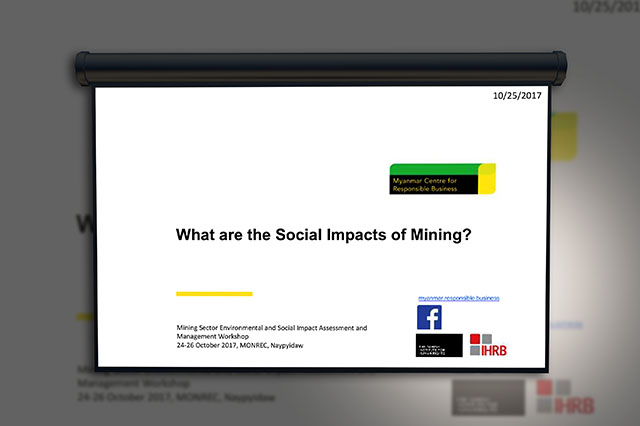Distinguish Between the Legal Obligations and Voluntary Efforts Needed for a Mine to Earn a ‘Social Licence to Operate’

From 24 to 26 October, MCRB collaborated with WWF Myanmar and the Ministry of Natural Resources and Environmental Conservation (MONREC) on a training workshop in Naypyidaw on Mining Sector Environmental and Social Impact Assessment and Management.
The workshop was attended by around 40 officials of the Environmental Conservation Department (ECD) and various mining related departments and mining state owned enterprises.
Vicky Bowman gave three presentations:
-
Responsible Mining
-
Social Impacts
-
Mining and Stakeholder Engagement
She first focussed on what constituted ‘responsible mining’ and the requirement on business to respect human rights and comply with legal obligations. Those legal obligations were a reflection of the government’s ‘duty to protect’ human rights from negative impacts of business.
Legal obligations on business included the obligation ideally to avoid, or if not reduce, mitigate or offset negative impacts. Vicky said that these were actions which should be identified in the EIA and included in Environmental Management Plan, and ‘commitments register’ or Environmental Compliance Certificate.
She stressed that it was important to distinguish between these compulsory requirements, and others which a mine project might want to take to earn a social licence to operate. This could include improving sustainability of the mine such as by reducing energy or water usage beyond actual legal requirements. They could include ‘creating shared value’, through actions such as building a local supply chain and training local people, that were good for the business, and good for society. It could also include simple philanthropy and donations.
However these actions should usually not be included in Environmental Management Plans, since it would make them legal obligations and reduce the company’s flexibility to react to changed circumstances and new opportunities.
Where the company’s actions and commitments involved local communities near the mine, and the mine was sufficiently long term, they could be incorporated into a structured ‘community development agreement’ to be negotiated – usually over several years - between the company and the communities. This could be a good strategy to earn a stronger social licence to operate, and build transparency and a governance structure for company-community engagement. Vicky also highlighted current Myanmar legal requirements for consultation and disclosure, and voluntary stakeholder engagement good practice throughout the mine cycle.
Using examples drawn from research in Myanmar, including for the MCRB forthcoming Sector-Wide Impact Assessment (SWIA) on Mining, participants were invited to identify whether particular actions by a company constituted a compulsory obligation, the creation of shared value and improved sustainability, philanthropy, or ‘other’, including potential corruption spending. The results (see ‘Responsible Mining Presentation’) demonstrated that it was not always easy to decide whether a mine’s support for local communities constituted ‘creating shared value’ or philanthropy. This was partly because there is such a strong business case for mines to stay on good terms with host communities in which they are a guest.
The workshop also examined typical social and environmental impacts of mining. Vicky explained that ‘social impacts’ were most easily defined as ‘impacts on people’. They could be a result of impacts on environment, culture, health, or governance, to name a few. It was therefore most effective to undertake a single impact assessment, whether called EIA, ESIA or ESHIA (under the Myanmar EIA Procedure, it is called ‘EIA’) which addressed all impacts.
Jonathan Hobbs, independent International Advisor on Mining and Environmental issues, working with WWF focussed also on ‘sustainable mining’, viewed from a metals ‘life-cycle’ perspective. He highlighted some significant environmental impacts of mining, including on wildlife and biodiversity, and techniques to address them. He explained how the environmental impact assessment (EIA) process could assist in identify and analysing ‘alternatives’ for the project, for example by using different technology, design or scheduling of activity, to reduce impacts.
Finally all speakers, and many of the participants agreed that the different stages of the mining cycle (prospecting, exploration, pre-feasibility, feasibility, construction, operation, closure and rehabilitation) required a differentiated approach to assessing and managing impacts. At the earlier stages, the need was for simple rules to be laid down by the Ministry. For example in prospecting and exploration, sites are scattered, and less likely to be significantly impacted, although particular care was needed concerning indirect impacts such as roads constructed for mining drill rigs which opened up sensitive forest to logging. However before the construction and operation stage, it was necessary to conduct, consult on and disclosure a full EIA/EMP for large, complex mines. A further EIA might be required at closure.
Read also
- Mining Sector
- Jade Mining in Kachin State – Environmental Management Plans
- Towards Responsible Gold Mining in Sagaing Region
- River Sand Extraction in Myanmar
- Experts object to firms’ plans to mine sand in Tanintharyi Region
 English
English မြန်မာ
မြန်မာ မြန်မာ (unicode)
မြန်မာ (unicode)








